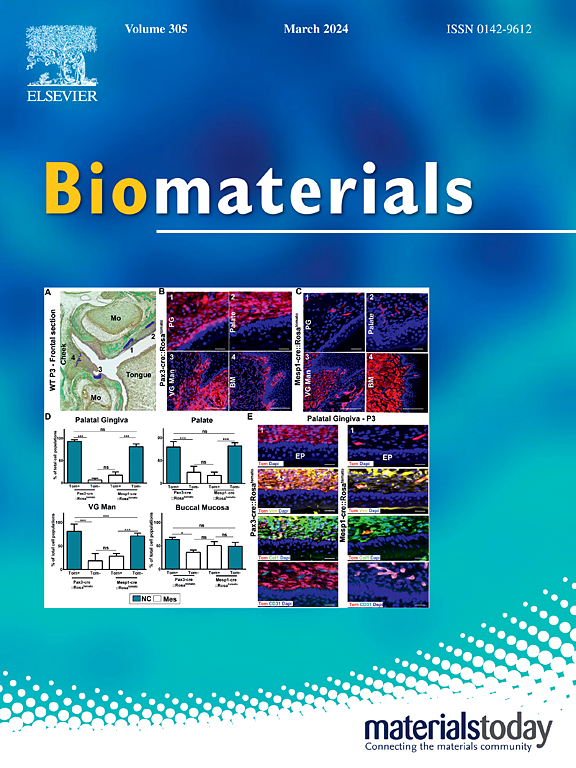用ahscs靶向肽pPB修饰间充质干细胞增强肝纤维化的治疗效果
IF 12.8
1区 医学
Q1 ENGINEERING, BIOMEDICAL
引用次数: 0
摘要
间充质干细胞(MSCs)具有治疗肝纤维化的巨大潜力,但由于在损伤部位的归巢效率不理想和滞留能力差,在转化方面面临挑战。活化的肝星状细胞(aHSCs)是肝纤维化的主要驱动因素,它过度表达血小板衍生生长因子受体-beta(PDGFRB),而PDGFRB是肝纤维化的有效治疗靶点。在这里,我们通过将 DMPE-PEG-pPB (DPP) 疏水插入间充质干细胞膜,设计出了 pPB 肽功能化的间充质干细胞(pPB-MSCs),从而创建了一种靶向的 "间充质干细胞-pPB-造血干细胞 "递送系统。我们的研究结果表明,pPB修饰能保持间充质干细胞的活力、分化潜能和旁分泌功能。pPB-间充质干细胞在体外与TGF-β1激活的造血干细胞有更高的结合亲和力,在TAA诱导的肝纤维化小鼠体内有更高的肝脏蓄积量,并通过体内成像进行量化。此外,pPB-间充质干细胞还能减轻胶原沉积,抑制α-SMA+造血干细胞,并使血清ALT/AST水平恢复到接近正常范围。从机制上讲,pPB-间充质干细胞通过上调 HGF 促进肝细胞再生,通过抑制 TGF-β/Smad 通路抑制上皮-间充质转化,并将巨噬细胞极化为 M2 表型,降低促炎性 IL-6/TNF-α,同时升高抗炎性 IL-10。总之,我们的研究提出了一种非遗传性间充质干细胞表面工程策略,它能协同 PDGFRB 靶向归巢和多因素组织修复,解决了细胞疗法治疗肝纤维化的关键障碍。通过在不损害间充质干细胞功能的情况下实现增强的空间输送,我们的方法为提高再生医学成果提供了一个可临床转化的平台。本文章由计算机程序翻译,如有差异,请以英文原文为准。

Modification of MSCs with aHSCs-targeting peptide pPB for enhanced therapeutic efficacy in liver fibrosis
Mesenchymal stem cells (MSCs) hold significant therapeutic potential for liver fibrosis but face translational challenges due to suboptimal homing efficiency and poor retention at injury sites. Activated hepatic stellate cells (aHSCs), the primary drivers of fibrogenesis, overexpress platelet-derived growth factor receptor-beta (PDGFRB), a validated therapeutic target in liver fibrosis. Here, we engineered pPB peptide-functionalized MSCs (pPB-MSCs) via hydrophobic insertion of DMPE-PEG-pPB (DPP) into the MSC membrane, creating a targeted “MSC-pPB-aHSC” delivery system. Our findings demonstrated that pPB modification preserved MSC viability, differentiation potential, and paracrine functions. pPB-MSCs exhibited higher binding affinity to TGF-β1-activated HSCs in vitro and greater hepatic accumulation in TAA-induced fibrotic mice, as quantified by in vivo imaging. Moreover, pPB-MSCs attenuated collagen deposition, suppressed α-SMA+ HSCs, and restored serum ALT/AST levels to near-normal ranges. Mechanistically, pPB-MSCs promoted hepatocyte regeneration via HGF upregulation, inhibited epithelial-mesenchymal transition through TGF-β/Smad pathway suppression, and polarized macrophages toward an M2 phenotype, reducing pro-inflammatory IL-6/TNF-α while elevating anti-inflammatory IL-10. Overall, our study raised a non-genetic MSC surface engineering strategy that synergizes PDGFRB-targeted homing with multifactorial tissue repair, addressing critical barriers in cell therapy for liver fibrosis. By achieving enhanced spatial delivery without compromising MSC functionality, our approach provides a clinically translatable platform for enhancing regenerative medicine outcomes.
求助全文
通过发布文献求助,成功后即可免费获取论文全文。
去求助
来源期刊

Biomaterials
工程技术-材料科学:生物材料
CiteScore
26.00
自引率
2.90%
发文量
565
审稿时长
46 days
期刊介绍:
Biomaterials is an international journal covering the science and clinical application of biomaterials. A biomaterial is now defined as a substance that has been engineered to take a form which, alone or as part of a complex system, is used to direct, by control of interactions with components of living systems, the course of any therapeutic or diagnostic procedure. It is the aim of the journal to provide a peer-reviewed forum for the publication of original papers and authoritative review and opinion papers dealing with the most important issues facing the use of biomaterials in clinical practice. The scope of the journal covers the wide range of physical, biological and chemical sciences that underpin the design of biomaterials and the clinical disciplines in which they are used. These sciences include polymer synthesis and characterization, drug and gene vector design, the biology of the host response, immunology and toxicology and self assembly at the nanoscale. Clinical applications include the therapies of medical technology and regenerative medicine in all clinical disciplines, and diagnostic systems that reply on innovative contrast and sensing agents. The journal is relevant to areas such as cancer diagnosis and therapy, implantable devices, drug delivery systems, gene vectors, bionanotechnology and tissue engineering.
 求助内容:
求助内容: 应助结果提醒方式:
应助结果提醒方式:


